There are many misconceptions about human trafficking – what it is, where it happens, and who it happens to. For National Slavery and Human Trafficking Prevention Month. HHS launched Look Beneath the Surface campaign to raise awareness of human trafficking and what we can all do to help end it.
Human trafficking affects men, women, and children around the world, including here in the United States. Many people think that human trafficking only happens in big cities, but it also happens in suburbs and rural areasVisit disclaimer page. Since 2007, the National Human Trafficking HotlineVisit disclaimer page identified more than 30,000 cases of potential trafficking reported from all 50 states, Washington, DC, and US territories.
Sex trafficking can happen in fake massage businesses, escort services, residential brothels, clubs and bars, hotels and motels, and on city streets and in truck stops. Labor trafficking can happen in the home and in industries spanning from agriculture and factories to hospitality and food services.
Human trafficking can happen to anyone –‑ U.S. citizens and foreign nationals, adults and children, across socio-economic, religious, and cultural backgrounds. Certain populations are at higher risk for trafficking, including survivors of child abuse and gender-based violence, homeless and socially disconnected adults and youth, American Indians and Alaska Natives, and migrants fleeing conflict and disasters.
What to Look For
Human trafficking is not an invisible crime. It can be spotted if you know what to look forVisit disclaimer page.
Look for individuals who:
- Are not free to leave or come and go as he/she wishes
- Show signs of being controlled — they may be fearful, anxious, submissive, tense or avoid eye contact
- Are unaware of current location, date, or time
- Are interrupted or stopped by someone else when they try to speak for themselves
- Do not have control of own money, identification, or other personal possessions
Also, not only is anyone under the age of 18 induced into commercial sex a victim of human trafficking, anyone who facilitates or participates in commercial sex with minors are considered sex traffickers under federal law.
So, what can you do?
Learn more
Understanding what trafficking is the best first step. The Look Beneath the Surface campaign provides an infographic exposing myths of human trafficking. The National Human Trafficking Hotline outlines additional common misconceptionsVisit disclaimer page.
If you are a health care provider, HHS provides the SOAR to Health and Wellness training for health care professionals and social service providers to “Stop, Observe, Ask, and Respond” to human trafficking.
Report Trafficking
If you see a potential trafficking situation or need help, call the National Human Trafficking HotlineVisit disclaimer page at 1-888-373-7888. The Hotline connects victims and survivors of trafficking to local service providers and also offers state byVisit disclaimer page state information on resources and local anti-trafficking events.
Know that you have a role to play
Recognize that human trafficking is not just an individual problem – it’s systemic. As consumers, we can know where our goods and servicesVisit disclaimer page come from. The US Department of Labor provides a list of goods produced by child labor or forced laborVisit disclaimer page (download their Sweat and Toil appVisit disclaimer page for easy access to information). Businesses can learn more on how to detect, prevent, and combat trafficking in supply chains through responsible sourcingVisit disclaimer page. Don’t be part of the demand for labor or sex trafficking.
We can work together to help End Trafficking.
Follow ACF on Twitter Visit disclaimer pageand Facebook Visit disclaimer pagein January to learn more about how you can help #EndTrafficking.
The ACF Office on Trafficking in Persons aims to combat human trafficking by supporting and leading systems that prevent trafficking through public awareness and protect victims through identification and assistance, helping them re-build their lives and become self-sufficient
More Resources
- Presidential Proclamation – National Slavery and Human Trafficking Prevention Month, 2017Visit disclaimer page
- National Human Trafficking Hotline

